演讲的艺术第11章delivering the speech教学设计
- 格式:docx
- 大小:86.95 KB
- 文档页数:6
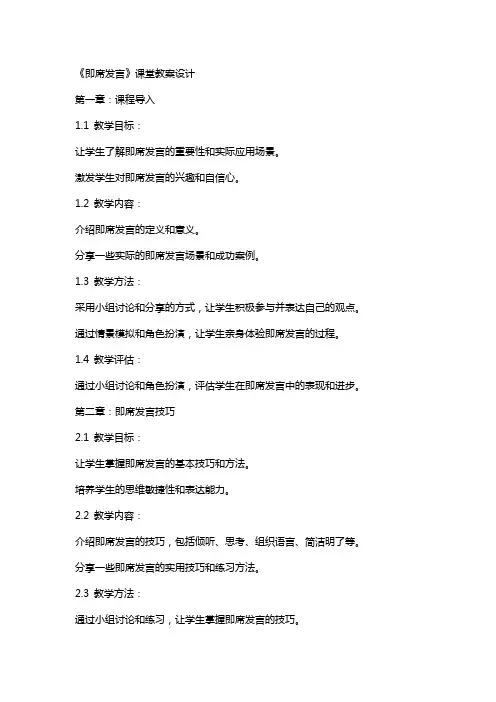
《即席发言》课堂教案设计第一章:课程导入1.1 教学目标:让学生了解即席发言的重要性和实际应用场景。
激发学生对即席发言的兴趣和自信心。
1.2 教学内容:介绍即席发言的定义和意义。
分享一些实际的即席发言场景和成功案例。
1.3 教学方法:采用小组讨论和分享的方式,让学生积极参与并表达自己的观点。
通过情景模拟和角色扮演,让学生亲身体验即席发言的过程。
1.4 教学评估:通过小组讨论和角色扮演,评估学生在即席发言中的表现和进步。
第二章:即席发言技巧2.1 教学目标:让学生掌握即席发言的基本技巧和方法。
培养学生的思维敏捷性和表达能力。
2.2 教学内容:介绍即席发言的技巧,包括倾听、思考、组织语言、简洁明了等。
分享一些即席发言的实用技巧和练习方法。
2.3 教学方法:通过小组讨论和练习,让学生掌握即席发言的技巧。
利用思维导图和口语练习,培养学生的思维敏捷性和表达能力。
2.4 教学评估:通过小组讨论和口语练习,评估学生在即席发言中的技巧掌握和运用能力。
第三章:即席发言策略3.1 教学目标:让学生了解即席发言的策略和技巧。
培养学生制定即席发言策略的能力。
3.2 教学内容:介绍即席发言的策略,包括分析听众、确定发言重点、运用修辞手法等。
分享一些即席发言的实用策略和案例分析。
3.3 教学方法:通过小组讨论和案例分析,让学生了解即席发言的策略。
利用角色扮演和情景模拟,培养学生制定即席发言策略的能力。
3.4 教学评估:通过小组讨论和角色扮演,评估学生在即席发言中制定策略的能力。
第四章:即席发言实践4.1 教学目标:让学生通过实际操作,提高即席发言的能力和自信心。
培养学生在不同场景下进行即席发言的能力。
4.2 教学内容:介绍不同场景下的即席发言实践,包括会议、面试、演讲等。
提供一些即席发言的实用模板和句型。
4.3 教学方法:通过情景模拟和角色扮演,让学生亲身体验不同场景下的即席发言。
利用小组讨论和口语练习,提高学生的即席发言能力。
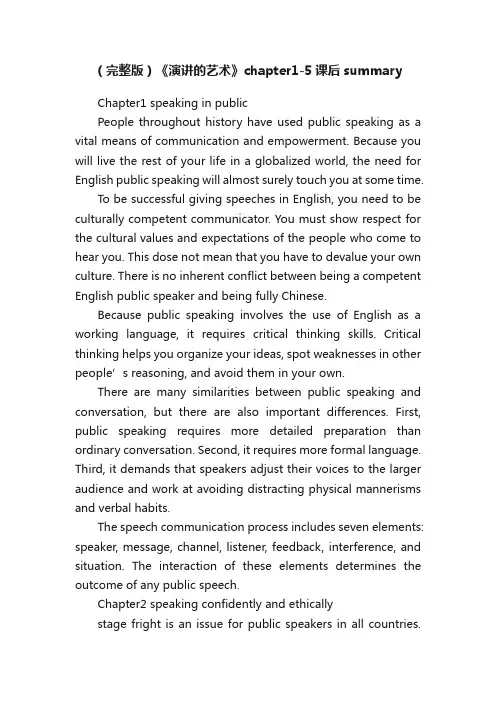
(完整版)《演讲的艺术》chapter1-5课后summaryChapter1 speaking in publicPeople throughout history have used public speaking as a vital means of communication and empowerment. Because you will live the rest of your life in a globalized world, the need for English public speaking will almost surely touch you at some time.To be successful giving speeches in English, you need to be culturally competent communicator. You must show respect for the cultural values and expectations of the people who come to hear you. This dose not mean that you have to devalue your own culture. There is no inherent conflict between being a competent English public speaker and being fully Chinese.Because public speaking involves the use of English as a working language, it requires critical thinking skills. Critical thinking helps you organize your ideas, spot weaknesses in other people’s reasoning, and avoid them in your own.There are many similarities between public speaking and conversation, but there are also important differences. First, public speaking requires more detailed preparation than ordinary conversation. Second, it requires more formal language. Third, it demands that speakers adjust their voices to the larger audience and work at avoiding distracting physical mannerisms and verbal habits.The speech communication process includes seven elements: speaker, message, channel, listener, feedback, interference, and situation. The interaction of these elements determines the outcome of any public speech.Chapter2 speaking confidently and ethicallystage fright is an issue for public speakers in all countries.Rather than trying to eliminate every trace of stage fright, you should try to transform it into positive energy. To some extent, this will happen naturally as you gain experience as a speaker, but you should also think positively, prepare thoroughly, visualize yourself giving a successful speech, remember that most nervousness is not visible to the audience, and think of your speech as communication rather than as a performance in which you must do everything perfectly Because public speaking is a form of power, it carries with it heavy ethical responsibili ties. There are four basic guidelines for ethical speechmaking. The first is to make sure your goals are ethically sound. The second is to be fully prepared for each speech. The third is to be honest in what you say. The fourth is to put ethical principles into practice at all timesOf all the ethical lapses a speaker can commit, few are more serious than plagiarism lobal plagiarism is lifting a speech entirely from a single source. Patchwork plagiarism involves cutting and pasting a speech from a limited number of sources. Incremental pla giarism occurs when a speaker fails to give credit for specific quotations and paraphrases that are borrowed from other people Because it is so easy to copy information from the Internet, it poses special challenges with regard to plagiarism. If you don't cite Internet sources, you are just as guilty of plagia- rism as if you take information from print sources without proper citation. As you research your speeches, be sure to take accurate notes of the Internet sources you use so you can identify them in your speechChapter3 giving your first speechOne of your first assignments will be to present an introductory speech, either a speech of self-introduction or aspeech introducing a classmate. Focus the speech on a limited number of ideas and be creative in developing them. Use interesting supporting materials and present them in colorful, descriptive language.When organizing the speech, make sure you have a clear introduction, body, and conclusion. Most introductory speeches fall naturally into chronological or topical order. Using clear transitions will help your audience follow you from point to point.Although you will write a complete manuscript or outline of your speech when preparing it, you should deliver it extemporaneously. This means you have rehearsed fully and can present your talk from a brief set of speaking notes. Concentrate on establishing eye contact with the audience and on speaking in a dynamic, engaged tonof voiceChapter4 selecting a topic and purposeThe first step in speechmaking is choosing a topic. If you have trouble picking a topic, you can use clustering, a personal inventory, or an Internet search to come up with something that is right for you.The general purpose of your speech will usually be to inform or to persuade. When your general purpose is to inform, your goal is to communicate information clearly, accurately, and interestingly. When your general purpose is to persuade, your goal is to win listeners over to your point of viewOnce you know your topic and general purpose, you must focus on a specific purpose statement that indicates precisely what your speech seeks to achieve. The specific purpose statement should (1) be a full infinitive phrase; (2) be worded as a statement, not a question:(3) avoid figurative language;(4) not be vague or general; (5) be appropriate for your audience; and(6)be achievable in the allotted time.The central idea is a concise statement of what you will say in your speech, and it usually crystallizes in your thinking after you have done your research and have decided on the main points. In most cases, it encapsulates the main points in a single declarative sentence Chapter5 analyzing the audience Good speakers are audience-centered. When working on your speeches, keep three questions in mind: To whom am I speaking? What do I want them to know, believe, or do as result of my speech? What is the most effective way of composing and presenting my speech to accomplish that aim?People are egocentric. They typically approach speeches with one question uppermost in mind: "why is this important to me?" Therefore you need to study your audience and adapt your speech to their beliefs and interests.The major factors to consider in audience analysis are size, physical setting, demographic traits disposition toward the topic, disposition toward the speaker, and disposition toward the occasion, For speeches outside the classroom, you can get information about the audience by asking the person who invites you to speak. For classroom speeches, you can circulate an audience-analysis questionnaire.Once you complete the audience analysis, you must adapt your speech so it will be clear and convincing. Try to hear the speech as your listeners will. Anticipate questions and objections, and try to answer them in advance. When you deliver the speech, keep an eye out for audience feedback, and adjust your remarks in response. After the speech, think about your audience's response and about changes you would make if you were delivering the speech again。

演讲的艺术(第八版)-个人笔记演讲的艺术(第八版)史蒂芬.E.卢卡斯/著俞振伟/译第一部分演讲与倾听第一章公共演讲公共演讲,即将你个人观点通过与他人分享并影响他人的态度从而达到公共化的一种途径。
通过演讲传播他们的思想,扩大他们的影响。
公共演讲在职业发展中非常重要,在日常生活中同样重要。
关键在于,公共演讲是一种能量赋予的形式。
他有可能促使人们十分关心的一些事情产生变化,实际情况的确经常如此。
在演讲课上掌握方法和策略。
实际上,与人讲话时,已经开始运用相当宽的知识范畴内的技能了。
1、逻辑清晰地组织自己的思想。
2、根据不同对象剪裁自己的话。
3、讲故事要达到最好效果。
你会不断调整自己的用词和语调,以便获得最佳效果。
4、接受听众的反馈。
意识到他的语言、面部和身体的反应。
你每天都在看似随意的谈话中所做这些事情,每天都做好了好多次,你根本没有意识到,自己已经具备了这些沟通技巧了。
所有这些都是你做公共演讲时必不可少的重要技巧。
公共演讲与日常对话的区别1、公共演讲结构更严谨。
公共演讲对演讲人有很严格的时间限制,多数情况下,不允许听众提问或发表评论打断演讲。
演讲人必须通过演讲本身实现自己实现自己的传达目标。
在准备演讲稿时,演讲人必须预计哪些部分有可能在听众中产生疑问,需要在演讲中回答这些疑问。
因此,公共演讲需要事先先做精心的准备。
2、公共演讲要求更正式的用语。
俚语、行话和不规范的表达在公共演讲中站不住脚。
3、公共演讲要求使用“演讲”的说话方式。
非正式谈话时,人们会保持闲散的姿势,使用很多语气词、做很多停顿(嗯、啊、这么、那么,等等)。
而有效的演讲人会调整自己的嗓音,以便让所有听众都能清晰的听到;站的直挺,避免出现让人走神的个人习惯动作和习惯用语。
树立信心:你的演讲课紧张纯属正常76%的人在走上讲台前也会怯场。
可是,紧张是一个健康的信号,表明他们在“心理上做好了准备”,准备让演讲取得成功。
肾上腺素水平急剧上升,使你心跳加快、双手颤抖、额头冒汗。

演讲的艺术-粤教版必修1教案一、教学目标1.了解演讲的定义、类型及基本要素。
2.掌握演讲的基本技巧。
3.能够为特定目的进行演讲。
4.提高学生的口头表达及沟通能力。
二、教学重点和难点1.教学重点:演讲技巧的讲解及实践。
2.教学难点:如何提高学生的口头表达和沟通能力。
三、教学内容3.1 概念解释1.什么是演讲?–演讲是指演说人以语言为工具,在一定环境和目的下,通过论证、议论和感染,达到改变或巩固听众对某个问题的看法和态度的一种活动。
2.演讲的类型–演讲可以分为政治演讲、商务演讲、学术演讲、庆典演讲、竞赛演讲等多种类型。
3.2 演讲的基本要素1.主题:演讲的核心,是演讲人要解决的问题或呈现的事实、情况。
2.论据:演讲人为支持主题所提出的事实、证据、论点,是演讲的“立意”。
3.结论:演讲人对主题所提出的总结,是演讲的“收尾”。
4.语言:演讲时使用的语言要精练、有力、生动,具有感染力和说服力。
3.3 演讲技巧1.发音、语调、语速的掌控:流畅、准确的发音、合理的语调和恰当的语速是演讲的基本要求。
2.姿态、目光、手势的运用:自然、舒展的姿态、自信的目光和鲜明的手势能够提升演讲的效果和说服力。
3.内容、结构、清晰度的保证:演讲内容要丰富、有条理、清晰易懂,让听众容易接受和理解。
3.4 模拟演讲1.学生自选或老师布置一个演讲主题,学生要准备演讲稿并进行模拟演讲。
2.其他同学对演讲稿及演讲表现进行评价,老师提出指导意见。
3.重点讲解和实践技巧。
四、教学方法1.讲授与演示相结合的方式。
2.提问与讨论交互式教学。
五、教学评估1.分组讨论:抽取几个不同的演讲主题,分组进行讨论,讨论内容与主题相关,时间限制一定。
2.模拟演讲:学生分别进行模拟演讲,老师和其他同学进行评价及指导。
3.作业:根据老师布置的一个演讲主题,要求学生准备好演讲稿并进行演讲。
六、教学资料1.《演讲的艺术》(第七版)著者:丘维声2.演讲技巧视频教程。
七、教学总结通过此次教学,学生了解了演讲的基本概念、类型和基本要素,掌握了演讲技巧和实践,能够为特定目的进行演讲,提高了学生的口头表达及沟通能力。
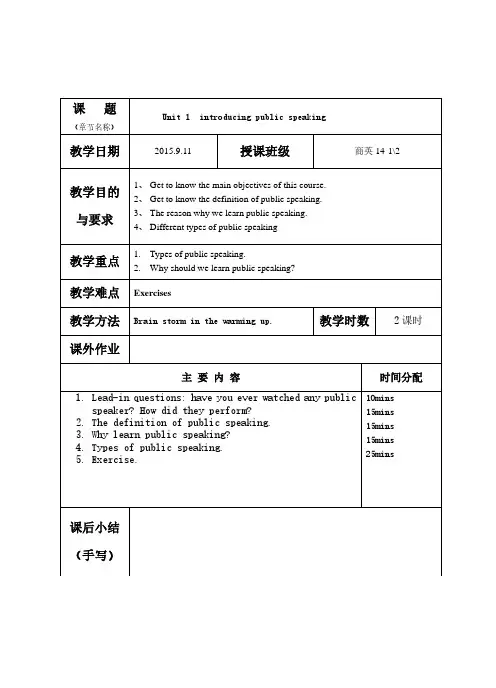
Speech Analysis: I Have a Dream – Martin Luther King Jr.Speech Video: Martin Luther King Jr. delivers “I Have a Dream”I encourage you to:1.Watch the video;2.Read the analysis in this speech critique;3.Study the speech text in the completetranscript; and4.Share your thoughts on this presentation.Speech Critique –I Have a Dream –Martin Luther King Jr.Much of the greatness of this speech is tied to its historical context, a topic which goes beyond the scope of this article. Analyze thespeech20mins主要内容教学思路时间分配Our privacy on the internet should be more protectedA good thesis for a speech could be: privacy on the Internet should be more protected by a ban on identity theft and safeguard genetic information, because everybody has the fundamental rights to have absolute control over his or her personal information.Does it introduce the contestable point and the claim you want to make?Is it not too board? Can you discuss the issue and claim in the given time limit?Does it announce what the audience should do, think or feel? Does it reveal the main speech topic?Is it simple, clear, and most and for all, direct?Is the speech thesis easy to remember and understand for them?Does it gain interest?Does it say way it is important?Does it contain a benefit?Exercise How to presentyourspeechthesis40mins20课题(章节名称)Unit5 constructing basic structure of a speech。
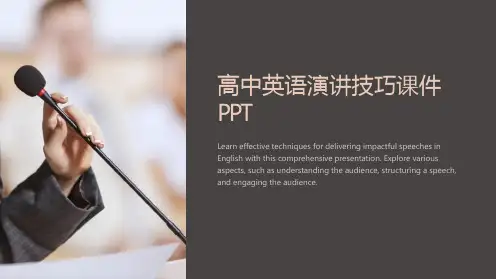
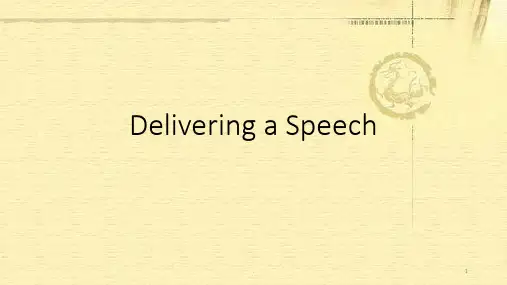
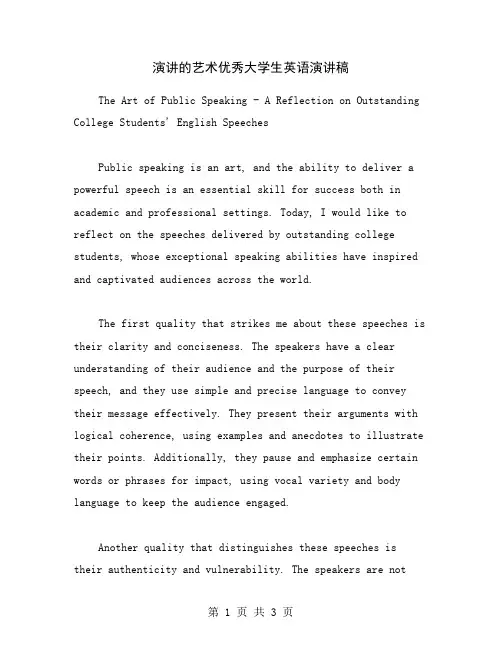
演讲的艺术优秀大学生英语演讲稿The Art of Public Speaking - A Reflection on Outstanding College Students' English SpeechesPublic speaking is an art, and the ability to deliver a powerful speech is an essential skill for success both in academic and professional settings. Today, I would like to reflect on the speeches delivered by outstanding college students, whose exceptional speaking abilities have inspired and captivated audiences across the world.The first quality that strikes me about these speeches is their clarity and conciseness. The speakers have a clear understanding of their audience and the purpose of their speech, and they use simple and precise language to convey their message effectively. They present their arguments with logical coherence, using examples and anecdotes to illustrate their points. Additionally, they pause and emphasize certain words or phrases for impact, using vocal variety and body language to keep the audience engaged.Another quality that distinguishes these speeches istheir authenticity and vulnerability. The speakers are notafraid to share their personal stories or opinions, even if they are controversial or unpopular. They speak from the heart, and their passion and conviction are palpable in their delivery. This authenticity allows them to connect with their audience on a deeper level, inspiring and motivating them to take action or think differently.Furthermore, these speeches demonstrate a deep appreciation for diversity and inclusivity. The speakers acknowledge and celebrate the differences among individuals and communities, and they advocate for greater understanding and acceptance. They use their platform to raise awareness of social issues, to challenge stereotypes and biases, and to promote a more equitable and just society.Lastly, these speeches reflect a strong sense of purpose and commitment. The speakers are not simply delivering a speech for the sake of it - they have a clear goal in mind, and they are passionate about making a difference. Whether they are advocating for environmental sustainability, promoting mental health awareness, or challenging gender norms, they demonstrate a deep sense of responsibility to their community and to the world.In conclusion, the art of public speaking is amultifaceted and complex skill that requires clarity, authenticity, inclusivity, and purpose. The speechesdelivered by outstanding college students embody these qualities, inspiring and empowering audiences across the world. As we navigate the challenges and opportunities of the 21st century, we must continue to cultivate this essential skill, recognizing the power of our words to change the world.。

《演讲》教案完美版第一章:演讲的基本概念与重要性1.1 演讲的定义1.2 演讲的类型与场合1.3 演讲的重要性1.4 演讲的基本要求1.5 教学目标与内容安排第二章:演讲的准备与组织2.1 确定演讲主题与目的2.2 收集与整理资料2.3 制定演讲提纲与结构2.5 演讲前的模拟练习2.6 教学目标与内容安排第三章:演讲的表达技巧与方法3.1 语言表达的清晰与准确3.2 声音的运用与控制3.3 肢体语言的运用3.4 情感的融入与表达3.5 演讲中的幽默与互动3.6 教学目标与内容安排第四章:演讲的呈现与评价4.1 演讲的台风与自信4.2 演讲的时间控制与节奏4.3 应对听众提问与互动4.4 演讲的评价标准与方法4.5 教学目标与内容安排第五章:实战演练与提升5.1 组织课堂演讲活动5.2 学生互相评价与反馈5.3 针对性的指导与改进5.4 演讲比赛的举办与评价5.5 教学目标与内容安排第六章:演讲技巧的提升与训练6.1 针对性的语音训练6.2 情感表达的深化训练6.3 肢体语言的丰富与训练6.4 思维逻辑的训练与提升6.5 实战演练与问题解决6.6 教学目标与内容安排第七章:演讲中的心理素质培养7.1 认识演讲中的心理障碍7.2 提高自信与自我激励7.3 应对紧张与焦虑的策略7.4 建立积极的心理暗示7.5 心理素质的实践锻炼7.6 教学目标与内容安排第八章:演讲与说服技巧8.1 了解听众与需求分析8.2 演讲中的说服力要素8.3 运用事实与数据增强说服力8.4 有效的论证与反驳技巧8.5 演讲中的感染力培养8.6 教学目标与内容安排第九章:特殊场合的演讲技巧9.1 政治演讲的特点与技巧9.2 商业演讲的目的与策略9.3 教育演讲的内容与方法9.4 文艺演讲的创意与表达9.5 不同场合演讲的适应性与灵活性9.6 教学目标与内容安排第十章:演讲的艺术与境界10.1 演讲的节奏与韵律10.2 演讲中的修辞手法与美感10.3 演讲的深度与哲理10.4 演讲者的个人风格与特点10.5 演讲的艺术境界与追求10.6 教学目标与内容安排重点和难点解析重点环节1:演讲的类型与场合解析:了解不同类型的演讲及其适用场合对于演讲者来说至关重要,这有助于演讲者根据听众的特点和演讲的目的选择合适的演讲方式和内容。

《演讲与口才教案》PPT课件第一章:演讲概述1.1 演讲的定义与分类1.2 演讲的作用与价值1.3 演讲的基本要求与评价标准1.4 PPT课件展示与讲解第二章:演讲者的修养2.1 演讲者的素质要求2.2 演讲者的心理素质2.3 演讲者的语言表达能力2.4 PPT课件展示与讲解第三章:演讲稿的写作技巧3.1 演讲稿的结构与要素3.2 演讲稿的开头与结尾3.3 演讲稿的语言运用3.4 PPT课件展示与讲解第四章:演讲技巧与艺术4.1 演讲的态势语言4.2 演讲的声音表达4.3 演讲的节奏与韵律4.4 PPT课件展示与讲解第五章:实战演练与点评5.1 学生演讲练习5.2 演讲评价与反馈5.3 优秀演讲案例分析5.4 PPT课件展示与讲解第六章:演讲准备与技巧6.1 演讲前的准备工作6.2 演讲者的自我调整6.3 演讲中的互动技巧6.4 PPT课件展示与讲解第七章:不同场合的演讲技巧7.1 商务演讲技巧7.2 教育培训演讲技巧7.3 政治演讲技巧7.4 PPT课件展示与讲解第八章:演讲中的视觉辅助工具8.1 PPT的制作与使用技巧8.2 实物演示与图片运用8.3 视频与音频的运用8.4 PPT课件展示与讲解第九章:即兴演讲与应对策略9.1 即兴演讲的技巧9.2 应对突发问题的策略9.3 如何在演讲中灵活运用知识9.4 PPT课件展示与讲解第十章:演讲比赛与实战训练10.1 演讲比赛的参赛技巧10.2 演讲比赛的评委标准10.3 实战训练与提升10.4 PPT课件展示与讲解重点和难点解析1. 第一章节的重点在于理解演讲的定义、分类、作用与价值,以及演讲的基本要求与评价标准。
学生需要掌握演讲的核心概念,并了解如何评价一场优秀的演讲。
2. 第二章节的难点在于培养学生的演讲者素质和心理素质,以及提升他们的语言表达能力。
教师需要通过各种练习和活动,帮助学生建立自信,提高他们在公众场合的表达能力。
4. 第四章节的难点在于教授学生如何运用态势语言、声音表达和演讲的节奏与韵律。
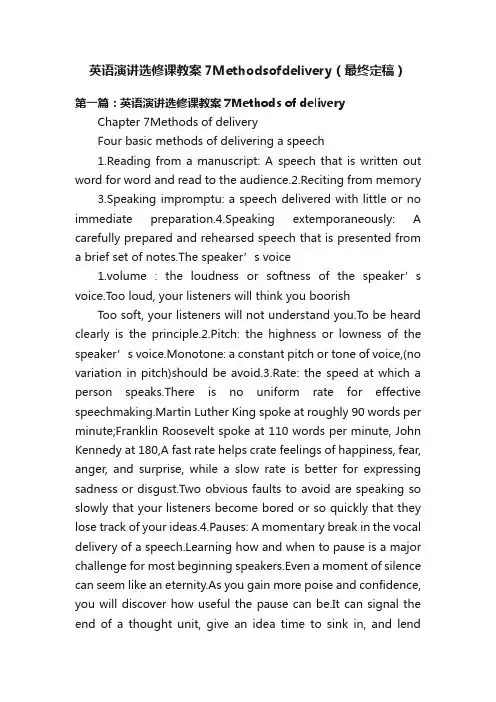
英语演讲选修课教案7Methodsofdelivery(最终定稿)第一篇:英语演讲选修课教案7Methods of deliveryChapter 7Methods of deliveryFour basic methods of delivering a speech1.Reading from a manuscript: A speech that is written out word for word and read to the audience.2.Reciting from memory3.Speaking impromptu: a speech delivered with little or no immediate preparation.4.Speaking extemporaneously: A carefully prepared and rehearsed speech that is presented froma brief set of notes.The speaker’s voice1.volume : the loudness or softness of the speaker’s voice.Too loud, your listeners will think you boorishToo soft, your listeners will not understand you.T o be heard clearly is the principle.2.Pitch: the highness or lowness of the speaker’s voice.Monotone: a constant pitch or tone of voice,(no variation in pitch)should be avoid.3.Rate: the speed at which a person speaks.There is no uniform rate for effective speechmaking.Martin Luther King spoke at roughly 90 words per minute;Franklin Roosevelt spoke at 110 words per minute, John Kennedy at 180,A fast rate helps crate feelings of happiness, fear, anger, and surprise, while a slow rate is better for expressing sadness or disgust.Two obvious faults to avoid are speaking so slowly that your listeners become bored or so quickly that they lose track of your ideas.4.Pauses: A momentary break in the vocal delivery of a speech.Learning how and when to pause is a major challenge for most beginning speakers.Even a moment of silence can seem like an eternity.As you gain more poise and confidence, you will discover how useful the pause can be.It can signal the end of a thought unit, give an idea time to sink in, and lenddramatic impact to a statement.When you do pause, make sure you pause at the end of a thought unit and not in the middle.Otherwise, you may distract listeners from your ideas.Most important, do not fill the silence with vocalized pauses like “uh”, “er”, or “um”.Mark Twain: The right word may be effective, but no word was ever as effective as a rightly timed pause.5.vocal variety: changes in a speaker’s rate, pitch, and volume that give the voice variety and expressiveness.Just as variety is the spice of life, so is it the spice of public speaking.A flat, listless, unchanging voice is just as deadly to speechmaking as a flat, listless, unchanging routine is to daily life.Diagnose your voice to decide which aspects need improvement.Record your speeches to hear how they sound.Try them out on your friends.And make adjustments.If you want to learn more, surf6.Pronunciation7.articulation: the physical production of particular speech sounds.WordMisarticulationought toottadidn’tdintforfurwant towannaThe speaker’s bodyPosture, facial expression, gestures, eye contact------all effect the way listeners respond to a speaker.Here are the major aspects of physical action that will affect the outcome of your speeches.Personal appearance : A number of studies have confirmed that personal appearance plays an important role in speechmaking.Listeners always see you before they hear you, so you should dress and groom appropriately.You should try to evoke a favorable first impression—an impression that is likely tomake listeners more receptive to what you say.Movement: As you rise to speak, try to appear calm, poised, and confident, despite the butterflies in your stomach.When you reach the lectern, don’t lean on it, and don’t rush into your speech.Give yourself time to get set.Arrange your notes just the way you want them.Stand quietly as you wait to make sure the audience is paying attention.Establish eye contact with your listeners.Then---and only then---should you start to talk.When you reach the end of your speech, maintain eye contact for a few moments after you stop talking.This will give your closing line time to sink in.All this advice is common sense, yet you would be surprised how many people need it.When practicing your speeches, spend a little time rehearsing how you will behave at the beginning and at the end.It is one of the easiest—and one of the most effective----things you can do to improve your image with an audience.GesturesThe rule is: whatever gestures you make should not draw attention to themselves and distract from your massage.They should appear natural and spontaneous, help clarify or reinforce your ideas, and be suited to the audience and occasion.Eye contact(direct visual contact with the eyes of another person) One of the quickest ways to establish a communicative bond with your listeners is to look at them personally and pleasantly.Avoiding their gaze is one of the surest ways to lose them.There is a great deal of research to show that speakers in the United States who refuse to establish eye contact are perceived as tentative or ill at ease and may be seen as insincere or dishonest.As you look at your listeners, be alert for their reactions: Can they hear you? Do they understand you? Are they awake? Your eyes will help you answer these questions.It is notenough just to look at your listeners: how you look at them also counts.A blank stare is almost as bad as no eye contact at all.So is a fierce, hostile glower or a series of frightened, bewildered glances.SummarySpeech delivery is a matter of nonverbal communication.It is based on how you use your voice and body to convey the message expressed by your words.You cannot make a good speech without having something to say, but you also need to know how to say it.Rather than calling attention to itself, effective delivery conveys the speaker’s ideas clearly, engag ingly, and without distracting the audience.There are four basic methods of delivering a speech:To use your voice effectively you should work on controlling your volume, pitch, rate, pauses, vocal variety, pronunciation, articulation.Posture, personal appearance, facial expression, gestures, and eye contact also affect the way listeners respond to speakers.第二篇:英语演讲选修课教案7Methods of deliveryChapter 7Methods of delivery Four basic methods of delivering a speech 1.Reading from a manuscript: A speech that is written out word for word and read to the audience.2.Reciting from memory Misarticulation ought tootta didn’tdint forfur want towannaThe speaker’s body Posture, facial expression, gestures, eye contact------all effect the way listeners respond to a speaker.Here are the major aspects of physical action that will affect theoutcome of your speeches.Personal appearance : A number of studies have confirmed that personal appearance plays an important role in speechmaking.Listeners always see you before they hear you, so you should dress and groom appropriately.You should try to evoke a favorable first impression—an impression that is likely to make listeners more receptive to what you say.Movement:As you rise to speak, try to appear calm, poised, and confident, despite the butterflies in your stomach.When you reach the lectern, don’t lean on it, and don’t rush into your speech.Give yourself time to get set.Arrange your notes just the way you want them.Stand quietly as you wait to make sure the audience is paying attention.Establish eye contact with your listeners.Then---and only then---should you start to talk.When you reach the end of your speech, maintain eye contact for a few moments after you stop talking.This will give your closing line time to sink in.All this advice is common sense, yet you would be surprised how many people need it.When practicing your speeches, spend a little time rehearsing how you will behave at the beginning and at the end.It is one of the easiest—and one of the most effective----things you can do to improve your image with an audience.GesturesThe rule is: whatever gestures you make should not draw attention to themselves and distract from your massage.They should appear natural and spontaneous, help clarify or reinforce your ideas, and be suited to the audience and occasion.Eye contact(direct visual contact with the eyes of another person)One of the quickest ways to establish a communicative bond with your listeners is to look at them personally and pleasantly.Avoiding their gaze is one of the surest ways to losethem.There is a great deal of research to show that speakers in the United States who refuse to establish eye contact are perceived as tentative or ill at ease and may be seen as insincere or dishonest.As you look at your listeners, be alert for their reactions: Can they hear you? Do they understand you? Are they awake? Your eyes will help you answer these questions.It is not enough just to look at your listeners: how you look at them also counts.A blank stare is almost as bad as no eye contact at all.So is a fierce, hostile glower or a series of frightened, bewildered glances.Summary Speech delivery is a matter of nonverbal communication.It is based on how you use your voice and body to convey the message expressed by your words.You cannot make a good speech without having something to say, but you also need to know how to say it.Rather than calling attention to itself, effective delivery conveys the speaker’s ideas clearly, engagingly, and without distracting the audience.There are four basic methods of delivering a speech:To use your voice effectively you should work on controlling your volume, pitch, rate, pauses, vocal variety, pronunciation, articulation.Posture, personal appearance, facial expression, gestures, and eye contact also affect the way listeners respond to speakers.第三篇:英语演讲选修课10informativeLesson 10 Informative Teaching Aim and Requirement Aimed at ensuring the Ss to have a basic knowledge of public speaking.Teaching methods PPt, interact between teacher & student AssignmentsWhat are the essentials of an effective speech? How to overcome nervousness? Teaching proceduresInformative speech: a speech designed to conveyknowledge and understanding ν T o enhance the knowledge and understanding of your listeners---to give them information they did not have before νConvey clearly accurately interestingly Organizational methodsν Chronological order编年顺序ν Spatial order空间顺序ν Topical order主题顺序ν Causal order ν Problem-solution orderOther methods of speech organizationν Causal order: A show a cause-effect relationship.method of speech organization in which the main pointsν Problem-solution order: A method of speech organization in which the first main point deals with the existence of a problem and the second main point presents a solution to the problem.ν(Problem-cause-solution order)Speeches about processνProcess: A systematic series of actions that leads to a specific result or product.νSpeeches of process explain how something is made, how something is done, or how something works.3.Speeches about eventsνEvent: Anything that happens or is regarded as happening.ν chronological order----to recount the history of an event, ν causal order----to explain the causes and effects4.Speech about conceptsνConcept: A belief, theory, idea, notion, principle, or the like.ν Speeches about concepts are usually organized in topical order.One common approach is to list the main features or aspects of your concept.Guidelines for informative speaking λDon’t overestim ate what the audience knows.* Lead youraudience step by step and explain everything thoroughly.2.Relate the subject directly to the audience* What is fascinating to the speaker may not be fascinating to everybody.* Get your listeners involved3.Don’t be too technical* Simple, clear language is needed.4.Avoid abstractions One way to avoid abstractions is through description(a statement that depicts a person, event, idea, or the like with clarity and vividness) Another way to escape abstraction is with comparisons(A statement of the similarities among two or more people, events, ideas, etc.)5.Personalize your ideas第四篇:英语演讲选修课11persuasiveLesson 11 Persuasive Teaching Aim and Requirement Aimed at ensuring the Ss to have a basic knowledge of public speaking.Teaching methods PPt, interact between teacher & student AssignmentsWhat are the essentials of an effective speech? How to overcome nervousness? Teaching proceduresI.Persuasive speeches on questions of factν Questions of fact---A question about the truth or falsity of an assertion.νWe do not know enough information to know what it isWill the economy be better or worse next year?Will another earthquake strike California before the year 2010? ν The facts are murky or inclusiveWhat will happen next in the Middle East?Is sexual orientation genetically determined?Speeches On questions of fact are usually organized topically II.Persuasive speeches on questions of valueνQuestions of value?---A question about the worth, rightness, morality, and so forth of an idea or action.ν What is the best movie of all time? Is the cloning of human beings morally justifiable? What are the ethical responsibilities of journalists? νMatter of fact, value judgments νSpeeches on questions of value are mostly organized topicallyν Your first main point is to establish the standards for your value judgment.树立价值判断的标准ν Your second main point is to apply those standards to the subject.III.Persuasive speeches on questions of policy Questions of policy---A question about whether a specific course of action should or should not be taken.是否采取行动What to do during spring vocation? Which strategy to use in selling a product? How to maintain economic growth and protect the enviroment ? ν They are to decide whether something should or should not be anizing speeches on Questions of policyλProblem-solution order λProblem-cause-solution orderλComparative Advantage orderλD.Monroe’s motivated sequenceD.Monroe’s motivated sequence门罗促动顺序νA method of organizing persuasive speeches that seek immediate action.ν The five steps of the motivated sequence are:1.attention2.need3.satisfaction4.visualization(形象化)5.actionPart 2: Methods of persuasionListeners will be persuaded by a speaker from one or more of four reasons:I.credibility.II.evidence.III.reasoning.IV.emotionsI.Building credibilityν Factors of credibility:petence---how an audience regards a speaker’s intelligence, expertise, and knowledge of the subject.B.Character---how an audience regards a speaker’s sincerity, trustworthiness, and concern for the well-being of the audience.2.Establishing common ground with your audience ν Creating common ground---a technique in which a speaker connects himself or herself with the values, attitudes, or experiences of the audience.3.Deliver your speeches fluently, expressively, and with conviction ing evidenceTips for using evidence e specific e novel e evidence from credible sources 4.Make clear the point of your evidence.III.Reasoningν Reasoning---the process of drawing a conclusion on the basis of evidence.ν Four types of reasoning:1.Reasoning from specific instances2.Reasoning from principle3.Causal reasoning4.Analogical reasoningGuidelines for reasoning from specific instancesA.Avoid generalizing too hastily, make sure your sample of specific instances is large enough to justify your conclusion.B.Be careful with your wording.If your evidence does not justify a conclusion, qualify your argument.C.Reinforce your argumentwith statistics and testimony 2.Reasoning from principle ν---Reasoning that moves from a general principle to a specific conclusion.For instance: νAll people are mortal.νSocrates is a person.νTherefore, Socrates is mortal.3.Causal reasoning---Reasoning that seeks to establish the relationship between causes and effects.νThere is a patch of ice on the sidewalk.You slip, fall, and break your arm.You reason as follows: “Because that patch of ice was there, I fell and broke my arm.” orν“If the patch of ice hadn’t been there, I wouldn’t have fallen and broken my arm.” ν4.Analogical reasoning(类比推理)---Reasoning in which a speaker compares two similar cases and infers that what is true for the first case is also true for the second.νIf you are good at racquetball, you’ll be great at Ping-Pang.ν In Great Britain the general election campaign fro Prime Minister lasts less than three weeks.Surely we can do the same with the U.S presidential election.IV.Appealing to emotions ν Emotional appeals are intended to make listeners feel sad, angry, guilty, afraid, happy, proud, sympathetic, reverent, or the like.These are often appropriate reactions when the question is one of value or policy.νGuidelines for generating emotional appealν e emotional language 2.Develop vivid example 3.Speak with sincerity and conviction第五篇:英语演讲选修课7language_delivery范文Lesson 7 Language delivery Teaching Aim and Requirement Acquire a basic knowledge of topic,purpose and central idea of a public speech。
英语戏剧性演讲教案初中Objective:The objective of this lesson is to help students develop their public speaking skills, particularly in delivering dramatic speeches. Through this lesson, students will also enhance their creativity, confidence, and ability to express emotions effectively.Materials:- Microphone- Speakercase or any portable speaker- Projector and screen (optional)- Handouts with speech prompts- Evaluation sheetsProcedure:1. Introduction (10 minutes)- Begin the class by introducing the topic of dramatic speeches and its importance in communication.- Explain that a dramatic speech is a form of public speaking that involves storytelling, emotions, and engaging the audience.- Share examples of famous dramatic speeches to give students an idea of the impact they can have.2. Warm-up Activity (15 minutes)- Divide students into pairs and have them practice delivering short dramatic speeches on random topics.- Encourage students to use emotions, tone, and body language to engage their partners.3. Speech Prompts (20 minutes)- Hand out speech prompts to students, which can include topics like historical events, personal experiences, or fictional scenarios.- Instruct students to choose a prompt and start preparing a dramatic speech based on it.4. Speech Preparation (30 minutes)- Give students some time to prepare their speeches. Encourage them to think about the emotions they want to convey, the tone of their speech, and the use of body language.- Offer assistance to students who need help with their speech preparation.5. Dramatic Speech Delivery (20 minutes)- Have students line up at the front of the class, ready to deliver their dramatic speeches. - Each student will take turns delivering their speech using the microphone and speakercase for a more engaging experience.- Encourage students to use emotions, tone, and body language to captivate the audience.6. Feedback and Evaluation (10 minutes)- After each student has delivered their speech, provide feedback on their performance. Focus on areas like emotions, tone, and engagement with the audience.- Have students self-evaluate their speeches using an evaluation sheet provided to them. 7. Conclusion (5 minutes)- Wrap up the lesson by summarizing the importance of dramatic speeches and the skills students have learned.- Encourage students to continue practicing their public speaking skills, especially in delivering dramatic speeches.Assessment:-Observe students' participation and engagement during the speech delivery.- Evaluate students' use of emotions, tone, and body language in their speeches.- Review self-evaluation sheets to gauge students' self-awareness and reflection on their performance.Note: This lesson plan can be adjusted based on the time available and the specific needs of your students.。
运用英语演讲稿掌握演讲艺术的要领In today's globalized world, effective communication skills have become an indispensable part of our personal and professional lives. Among the various forms of communication, public speaking, or the art of delivering a persuasive message to a live audience, has gained special attention. Public speaking has been considered the hallmark of leadership and success, and mastering its nuances has become more critical than ever before. In this article, we will explore the essential elements of public speaking and how to use the English language to excel in this art.First and foremost, public speaking requires a speaker to connect with the audience emotionally and intellectually. This means that the speaker must have a thorough understanding of the audience's needs, expectations, and preferences. Knowing the target audience will help the speaker tailor their message accordingly and increase its impact. For instance, if the audience consists of professionals, using technical jargon and industry-specific terminology might be necessary to convey the message clearly.Secondly, a successful speech must have a clear and concise structure. This means that the speaker must definethe purpose of the speech and communicate it to the audiencein a straightforward manner. A speech should have an introduction, where the speaker establishes rapport with the audience and arouses their interest; a body, where thecentral theme is explained, illustrated, and reinforced; anda conclusion, where the speaker summarizes the main pointsand leaves a lasting impression.Thirdly, a successful speech must be engaging. This means that the speaker must use a variety of techniques and toolsto capture and retain the audience's attention. These techniques include storytelling, humor, anecdotes, statistics, and visuals. When used correctly, these techniques can transform a mundane message into an exciting and memorable experience.Fourthly, a successful speech must be delivered with confidence and conviction. This means that the speaker must practice and rehearse their speech repeatedly. Rehearsingwill help the speaker refine their message, reduce anxiety, and improve their delivery. Delivering the messageconfidently and with conviction will increase the audience'sconfidence in the speaker and create a sense of trust and credibility.Fifthly, the use of the English language can greatly enhance the speaker's ability to deliver an effective speech. English is a universal language, and mastering it can increase the speaker's reach and influence. Moreover, English has a vast vocabulary and rich expressions that can express ideas and emotions accurately and elegantly. The use of idioms, metaphors, and proverbs in a speech can add depth and richness to the message and help the audience engage with the speaker on a deeper level.In conclusion, public speaking is a skill that can be mastered with practice, perseverance, and dedication. By incorporating the essential elements of audience analysis, clear structure, engagement, confidence, and the use of the English language, speakers can master this art and achieve their communication goals. Speaking publicly can be daunting, but with the right tools and techniques, it can be a rewarding and fulfilling experience that can bring vast opportunities and transform the speaker's personal and professional life.。
语言、人文与艺术课程名称:口才艺术(The Art of Eloquence)一、课程目的、任务:“演讲学”是研究口语表达特点和规律的学科。
“演讲学”课程是运用口才学理论指导大学生提升口头表达能力的应用性课程。
因此,它具有科学的训练系统和很强的操作性。
优秀的口头表达能力是一个人学习、工作、发展所必备的。
大学生如果只有较为全面的知识基础,而缺乏体现个人综合素养的优秀口才,便难以在未来社会中获得更大的发展空间。
所以,设置该课程能够给大学生提供一个系统学习、模拟实战的机会,使他们的口头表达能力有较为明显的提高。
为大学生走上工作岗位打好自信力和表达力的基础。
二、课程内容:本课程由两部分组成。
第一部分为“基本能力”。
以“过三关、练五力”为主要框架,通过互动操练、情境模拟、实境演练、案例分析,培养学生的五力:自信力、感染力、说服力、沟通力、应变力;帮助学生闯过三关:心理素质关-;方法技能关;内涵修养关。
最终通过自身努力成为能言善辩的人才。
第二部分为“实际运用”。
主要讲授演讲、谈判等专门口才学习的方法。
本课程共36学时。
考核方式为口试。
教学对象为全校各专业本科生。
三、教学方式、实践环节的特色:基本原则:精讲多练、互动教学、案例分析、情境模拟。
以课堂内外模拟场景演练为方法,讲课堂延伸到教室之外乃至校园之外,通过实践提升学生水平,凸现应用性学科的实践特点。
四、教材及参考书目:自编讲义《能言善辩——口才学习“五力训练法”》五、考核方式与评价结构比例:考核方式:口试。
平时实践活动占总评比例40分,期末口试占60分。
口试内容:演讲、答辩、情境再现六、讲授大纲:序论:课程内容、意义、教学方法介绍第一章自信力训练第一节心理突破的意义第二节心理素质的检验第三节心理突破的方法第二章感染力训练第一节声音训练第二节朗读训练第三节态势训练第四节描述训练第三章说服力训练第一节思维训练第二节说理训练第四章沟通力训练第一节听能训练第二节复述训练第三节问答训练第四节交谈训练第五章应变力训练第一节演讲应变训练第二节辩论应变训练第三节其他应变训练第六章演讲第一节有准备的演讲第二节即兴演讲第七章谈判第一节谈判基本理念、方式介绍第二节谈判口才七、教学时数分配:总时数36课时课程名称:红楼梦研究(Studies on Dream of the Red Chamber)一、课程目的、任务:(1)在“全球化”背景下,凸显民族文学的经典之作,了解其在世界文明进程中的伟大地位与重要作用,从而使学生认识到越是民族的就越是世界的,纠正将“全球化”沦为“西方化”的错误倾向。
Delivering the speech-the speaker’s voice and body (演讲者的声音和肢体语言) 教学设计
一、基本情况
所属课程:英语演讲与口才
课程性质:专业限选课
所用教材:The Art of Public Speaking(演讲的艺术)
本课题目:Delivering the speech-the speaker’s voice and body
(演讲者的声音和肢体语言)
授课对象:商务英语专业大一年级第二学期的学生
课时数:1课时(本课程共34课时)
二、教学内容
(一)主要教学内容
1.The seven aspects of the speaker’s voice.(演讲者的声音所涉及的七个
方面。
)
2.Major aspects of the speaker’s body.(演讲者的肢体语言)
(二)教学重点及难点
重点:the aspects of the speaker’s voice(pause\rate\vocal variety\pronunciation).The speaker’s eye contact and gestures.
难点:the speaker’s eye contact and gestures.
三、学情分析
(一)学生学习基础
从宏观的课程层面来说,学生在第一学期已经修完了英语语音、综合英语、英语口语、英语听力、英语写作等基础课程,听说技能已经得以提升。
同时,在听说课堂上学生的英语演讲能力也得以锻炼。
从微观的内容层面来说,在学习本章之前,学生已经完成了前十章公共演讲、演讲者的自信心和道德观、第一次演讲、话题选择、观众分析、论证观点、组织演讲主体、开头和结尾、撰写提纲、语言的应用有了深入的了解和练习。
(二)学生可能遇到的问题
1. 演讲者的声音及肢体语言多数情况下受到学生平时语言表达习惯的影
响,因此,学生首先要意识到如何调节表达的音调、语速、音高等; 2. 很多学生对自己已有的肢体语言习惯没无意识;
3. 学生没有认识到声音及肢体语言在演讲中所起到的重要作用。
(三)学生的学习习惯
学生倾向于采用纯粹阅读法来学习,从而制约了对教学内容所涉及的方法论层面的理解及应用。
也缺乏深入挖掘文化背景知识的习惯。
(一)知识目标
1. Understand the seven aspects of voice you should work to control.
2. Understand the importance of the speaker’s body. (二)技能目标
1. Can adjust your voice when giving a speech.
2. Can use your body language appropriately. (三)情感态度目标
1. Positive attitude and appropriate skills when communicating with the
others.
英语演讲能力的提升需要学生自身大量的练习和实践,
撇开语言能力,学生在演讲及交流过程中,最缺乏的是有逻辑、有结构地表达自己的观点。
因此,本课采用的是“提出问题
——分析问题——解决问题
”的教学思路,一方面在教学过程中体现逻辑架构,一方面训练学生的思辨能力。
本课中的整体思路如下:
四、教学目标
六、教学方法及手段
五、教学理念
(一)主要采用的教学方法
本课中主要采用了讲授法、问题探究法、案例法及演示法。
1.在本课导入阶段,教师通过示范的形式表达声音及肢体运用不当所产
生的影响,如语速过快、停顿不当、音量过低或者过高、手势不当、
眼神交流不当等。
2.对于重点语言点的讲解采用传统的讲授法。
3.通过视频及教师现场模拟的方式演示正确的声音及肢体表达。
(二)主要采用的教学手段
1.传统的板书;
2.图片、音频、视频、案例等相结合的现代化多媒体教学手段。
七、教学过程设计
八、教学反思
授课结束后进行教学反思。